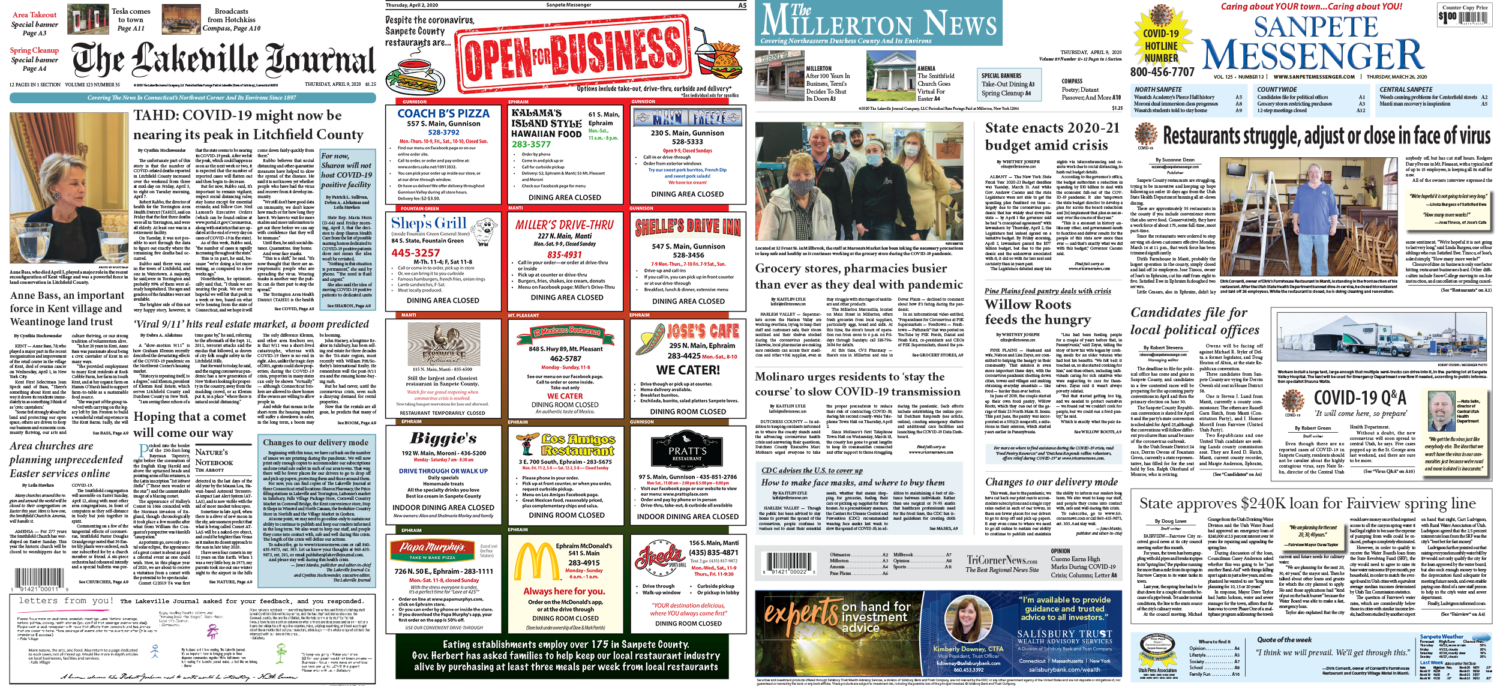Editors of community newspapers, an often overlooked but critically important element of the U.S. media ecosystem, are front-line responders in the coronavirus crisis.
The nation’s 7,000 non-daily community newspapers have been hit just as hard as daily papers and online news sites as the global economy shudders to a halt and advertising evaporates.
Some have suspended their print editions or sharply trimmed their print runs. Publishers have reluctantly laid off longtime staffers. But the mission, to inform communities and keep them safe, has never been more crucial.
“It’s a double whammy,” said Bill Reader, the co-author of “Foundations of Community Journalism” and a journalism professor at Ohio University. Weekly newspapers “are busier than they’ve ever been covering local edicts, local closures, providing essential information — and at the same time, getting almost no revenue.”
As the aridity of news deserts — communities entirely lacking in local reporting — spreads across the country, weekly papers have increasingly become the sole source for that essential information, especially in rural communities — areas that often have spotty broadband access and elderly populations, making the idea of cutting costs by moving entirely online a nonstarter, Reader said.
In the early days of the crisis, as mandates for social distancing spread slowly and local governments tried to square safety concerns with public access, weekly editors were at the forefront of fights to ensure that officials would define news organizations as essential businesses. Many were successful.
Missy Layfield, editor of the Island Sand Paper in Fort Myers, Florida, wrote on March 20: “I reached out via email to all 5 council members with a request that should they decide to close ‘non-essential’ businesses, they consider the newspaper as essential and got immediate agreement from three of them. Don’t expect problems from the other two.”
She added, “We have lots going on here as we are one of Florida’s spring break destinations and they just won’t leave. As a result, we’ve had three emergency meetings this week.”
[the_ad id=”667826″]
In North Lake Tahoe, California, Mayumi Elegado has been battling with health departments in the four counties covered by Moonshine Ink, the paper she owns and runs, for detailed information on testing and infection rates.
“The standard for sharing information is uneven,” she said, and the stakes are high: “To fight the virus, we need an army of informed and engaged citizens.”
Weeklies’ editors and publishers have put their mission first, but they’ve had to get creative to keep the lights on.
“We started for next week by going subscriptions only and cutting back to one dealer per town we go into,” Janet Manko, editor-in-chief and publisher of The Lakeville Journal, which publishes two papers covering northwestern Connecticut and rural Dutchess County, New York, wrote in an email.
For papers in rural communities, every dollar makes a difference.
In South Carolina, Betsy Finklea, editor of the 126-year-old Dillon Herald, ran a promotion thanking health care workers.
“We sold 68 spots to businesses, politicians and elected officials, local citizens, and churches” for $26 apiece, Finklea said. “We brought in $1,768.”
State news associations, a vital resource for weekly papers, are running special COVID-19 pages on their websites that link to reliable sources. They are providing Slack channels, house ads and PSAs, advice on the federal stimulus package and suggestions for encouraging advertisers to stick with their buys, like this presentation from media sales expert Ryan Dohrn on the New York Press Association’s website.
On New York’s Long Island, a two-county suburban region of 3 million people that at one point accounted for more than 20% of the besieged state’s COVID-19 cases, weekly newspaper publisher Steven Blank tried throwing a buoy to local businesses. Some 119 people had died in the county his six newspapers serve just the day before.
In an email, he offered advertisers new marketing vehicles at reduced prices: a free online directory of open businesses; sponsorship of the directory, of email blasts, of the newspapers themselves “to demonstrate your commitment to our papers and the communities they serve”; discounted display ads, discounted website advertising.
Revenues were vanishing. “Legal notices for school districts, anything with entertainment—promotions, that went away, venues went away,” Blank said. And real estate, his biggest category, was decimated: “If people were thinking about selling a house, they’re definitely not doing that in Nassau County.”
[the_ad id=”667872″]
On the listserv of the International Society of Weekly Newspaper Editors, with 300 members globally, questions about strategies flew. One active thread addressed what to do when high school sports, a mainstay of weeklies’ coverage, go away.
Suzanne Dean, editor of the Sanpete Messenger in central Utah, normally puts out fall, winter and spring sports supplements, and a summer supplement for high school graduates.
“We bill up front for the whole year and bring in about $13,000, which is a notable amount for a small paper,” Dean said. With spring sports canceled and thus no spring supplement, “rather than be in a position of having to refund money to 200 advertisers, which is an expense we don’t need right now, we are emailing all of them and telling them that instead of the spring booster, we’re going to do a thank-you to first responders, medical professionals and our local health department staff. We’re asking if they would support the thank-you publication in lieu of the spring booster, and I’m sure 90% will.
“I am a journalist first, then a businesswoman,” she added. “I’m most proud of the fact that in the four issues from March 19 to April 9, our staff of one full-time and two part-time reporters, plus four stringers, generated 30 items about the impact of the new coronavirus on our county.”
[the_ad id=”667878″]
Barbara Selvin, an associate professor at the Stony Brook University School of Journalism, writes frequently about weekly newspapers.






